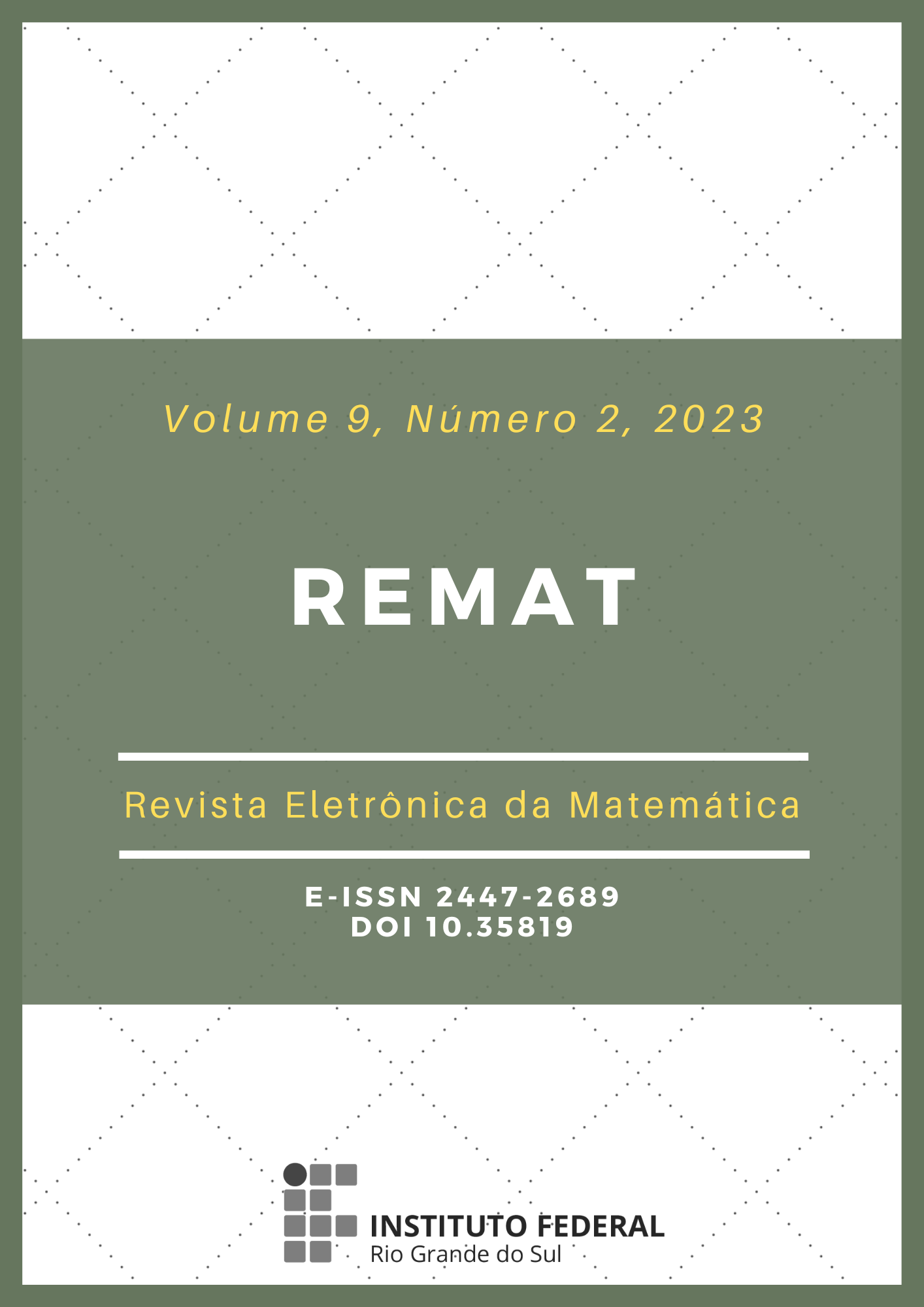Circular statistics: a directional study, via geographic coordinates, of students approved at the Air Cadet Preparatory School
DOI:
https://doi.org/10.35819/remat2023v9i2id6635Keywords:
directional average, circular standard deviation, trigonometric functions, circular boxplotAbstract
Circular statistics has applications in several areas whose data have directions, angles or periodic behavior, such as: direction of migration of animals, winds or geological materials, times of peak traffic or the birth of an insect, in addition to geographic coordinates among others. However, in our daily lives, we can instinctively evaluate, in a wrong way, data with angular characteristics in a classical way, using linear descriptive statistics. Thus, the objective of this work was to study the theory of circular statistics and compare the results with linear descriptive statistics, which is used for data on the real line and contemplated in regular education. In addition, the importance of the study of circular statistics for angular data was highlighted, along with the presentation of circular graphs, with the aid of the software R. For the application of the theory, a set of real data of the geographical coordinates of the cities of origin of students of the Air Cadet Preparatory School (EPCAR) was used, comparing the statistical measures of three different years of entry.
Downloads
References
AYRES, Manuel; Jr. AYRES, Manuel; AYRES, Daniel Lima; SANTOS, Alex de Assis Santos dos. BioEstat: aplicações estatísticas nas áreas das ciências bio-médicas. Belém, PA: Instituto Mamirauá, 2007.
BRASIL. Ministério da Educação. Base Nacional Comum Curricular. Brasília, DF, 2018. Disponível em: http://portal.mec.gov.br/docman/abril-2018-pdf/85121-bncc-ensino-medio/file. Acesso em: 15 set. 2022.
FALCONI, Carlos Eduardo. Calculando distâncias e direções utilizando coordenadas geográficas. Piloto Policial. 23 set. 2009. Disponível em: https://www.pilotopolicial.com.br/calculando-distancias-e-direcoes-utilizando-coordenadas-geograficas/. Acesso em: 3 nov. 2022.
GÓIS, Joaquim Eduardo Souza. Contribuição dos modelos estocásticos para o estudo da climatologia urbana. Orientadores: Henrique José de Figueiredo Garcia Pereira e Carlos Manuel Novais Madureira. 2002. 685 f. Tese (Doutorado) - Faculdade de Engenharia, Universidade do Porto, Porto, Portugal, 2002.
JAMMALAMADAKA, Sreenivasa Rao; SENGUPTA, Ashis. Topics in circular statistics. Series on Multivariate Analysis. v. 5. New Jersey: World Scientific, 2001.
MARDIA, Kantil. Statistics of directional data. London: Academic Press, 1972.
MENEZES, Eliane Barbosa. Um estudo direcional dos estudantes que chegam à UFRB: uma aplicação da estatística circular. Orientadores: Silvia Patrícia Barreto Santana e Celso Luiz Borges de Oliveira. 2018. 50 f. Trabalho de Conclusão de Curso (Bacharelado em Ciências Exatas e Tecnológicas) - Universidade Federal do Recôncavo da Bahia, Cruz das Almas, Bahia, 2018.
PEWSEY, Arthur; NEUHÄUSER, Markus; RUXTON, Graeme D. Circular statistics in R. Oxford: Oxford University Press, 2013.
R Development Core Team. R: A Language and Environment for Statistical Computing. Vienna, Austria: R Foundation for Statistical Computing, 2021. ISBN 3-900051-07-0. Disponível em: https://www.r-project.org/. Acesso em: 3 ago. 2022.
SANAR. Linha do tempo do coronavírus no Brasil. 19 mar. 2020. Disponível em: https://www.sanarmed.com/linha-do-tempo-do-coronavirus-no-brasil. Acesso em: 23 abr. 2023.
SILVA, Clodoaldo Teodosio Santana da; BRIGHENTI, Carla Regina Guimarães; RESENDE, Luiz Fernando Silva. Estatística circular aplicada aos dados de localização dos municípios de origem dos alunos do PROFMAT-UFSJ - Campus Santo Antonio. Revista de Matemática de Ouro Preto, Minas Gerais, v. 1, p. 1-10, nov. 2022. Disponível em: https://periodicos.ufop.br/rmat/article/view/5216. Acesso em: 26 dez. 2023.
Downloads
Published
Issue
Section
License
Copyright (c) 2023 REMAT: Revista Eletrônica da Matemática

This work is licensed under a Creative Commons Attribution 4.0 International License.
REMAT retains the copyright of published articles, having the right to first publication of the work, mention of first publication in the journal in other published media and distribution of parts or of the work as a whole in order to promote the magazine.
This is an open access journal, which means that all content is available free of charge, at no cost to the user or his institution. Users are permitted to read, download, copy, distribute, print, search or link the full texts of the articles, or use them for any other legal purpose, without requesting prior permission from the magazine or the author. This statement is in accordance with the BOAI definition of open access.













 https://orcid.org/0000-0002-0893-7426
https://orcid.org/0000-0002-0893-7426


















